Human interaction with cats
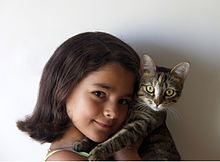
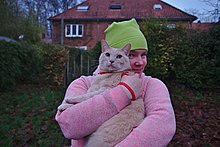
Human interaction with cats relates to the hundreds of millions of cats that are kept as pets around the world. The inter-relationship involves companionship, communication and caregiving. Dating back thousands of years, cats were originally domesticated for their ability to control pests and later became valued companions. Cats communicate through vocalizations, body language and behaviors, forming strong bonds with their human owners. Owners provide the food, shelter, and medical care, while play and enrichment activities stimulate their physical and mental well-being. Despite their independent nature, cats enjoy human company and require understanding of their unique behaviours. Positive reinforcement training can shape desired behaviours, fostering a harmonious relationship between humans and their feline companions, built on mutual respect and affection.
Pets
[edit]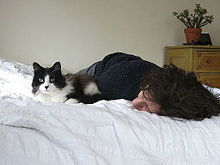
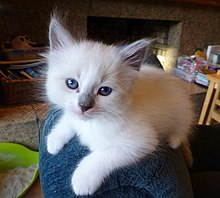
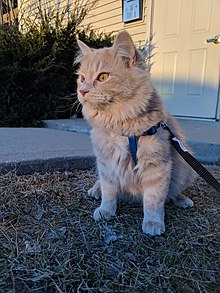
Cats are common pets in all continents of the world permanently inhabited by humans, and their global population is difficult to ascertain, with estimates ranging from anywhere between 200 million to 600 million.[1][2][3][4][5][6] In 1998 there were around 76 million cats in Europe, 7 million in Japan and 3 million in Australia.[7]: 4 A 2007 report stated that about 37 million US households owned cats, with an average of 2.2 cats per household giving a total population of around 82 million; in contrast, there are about 72 million pet dogs in that country.[8] Cats exceeded dogs in number as pets in the United States in 1985 for the first time, in part because the development of cat litter in the mid-20th century eliminated the unpleasantly powerful smell of cat urine.[9]
A 2007 Gallup poll reported that men and women in the United States of America were equally likely to own a cat.[10] The ratio of pedigree/purebred cats to random-bred cats varies from country to country. However, generally speaking, purebreds are less than 10% of the total population.[11]
As of 2021[update] in the United States, human owners of cats typically keep cats indoors at all times.[12] In typically rural settings, cats oftentimes live outside and are used as a deterrent to rodents, snakes, and other pests. In the United Kingdom most cats go outdoors from time to time, with 26% being indoors at all times.[12]
The compulsive hoarding of cats, a symptom of obsessive compulsive disorder (OCD), has long been associated with "cat ladies" although there is no evidence that older women are more likely than other people to hoard cats.[13]
Fur
[edit]According to the Humane Society of the United States, as well as being kept as pets, cats are also used in the international fur trade.[14] Cat fur is used in coats, gloves, hats, shoes, blankets and stuffed toys. About 24 cats are needed to make a cat fur coat.[15] This use has now been outlawed in several countries, including the United States, Australia and the European Union countries.[16] However, despite being outlawed, some cat furs are still made into blankets in Switzerland as folk remedies that are believed to help rheumatism.[17]
Pest control
[edit]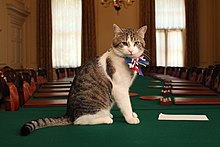
Cats, as with the traditional farm cat and ship's cat, are also used for pest control, particularly in the case of rat or mouse infestation.[18][19] As such, they are sometimes referred to as a "mouser",[20] and in the United Kingdom there has been one at Number 10 since the 1500s (officially titled 'Chief Mouser to the Cabinet Office' since 2011; additional duties include "greeting guests to the house, inspecting security defences, and testing antique furniture for napping quality").[21]
Domesticated varieties
[edit]The current list of cat breeds is quite large, with the US Cat Fanciers' Association recognizing 41 breeds, of which 16 are "natural breeds" that probably emerged before humans began breeding pedigree cats, while the others were developed over the latter half of the 20th century.[22] Because of common crossbreeding, many cats are simply identified as belonging to the homogeneous breeds of domestic longhair and domestic shorthair, depending on their type of fur.
Effects on human health
[edit]Because of their small size, domesticated house cats pose little physical danger to adult humans. However, in the US cats inflict about 400,000 bites per year that result in emergency room visits, almost 90% of which may be bites from provoked animals.[23] This number represents about one in ten of all animal bites.[23] Cat bites may become infected,[24] sometimes with serious consequences such as cat-scratch disease, or, very rarely, rabies.[23] Cats may also pose a danger to pregnant women and immunosuppressed individuals, since their feces, in rare cases, can transmit toxoplasmosis.[25] A large percentage of cats are infected with this parasite, with infection rates ranging from around 40 to 60% in both domestic and stray cats worldwide.[26][27][28] Research indicates a correlation between the parasite Toxoplasma gondii, which sexually reproduces exclusively in cats, and numerous human psychiatric conditions, including OCD.[29]
Allergic reactions to cats are relatively common, happening in as many as every 3 in 10 Americans.[30] The major allergen, Fel d 1, is found in the saliva and/or dander of all cat breeds.[31] There have been attempts to breed hypoallergenic cats, which would be less likely to provoke an allergic reaction.[32][33] Some humans who are allergic to cats—typically manifested by hay fever, asthma, or a skin rash—quickly acclimate themselves to a particular animal and live comfortably in the same house with it, while retaining an allergy to cats in general.[34][better source needed] Whether the risk of developing allergic diseases such as asthma is increased or decreased by cat ownership is uncertain.[35][36] Some owners cope with this problem by taking allergy medicine, along with bathing their cats frequently, since weekly bathing will reduce the amount of dander shed by a cat.[37]
As well as posing health risks, interactions with cats may improve health and reduce physical responses to stress: for example the presence of cats may moderately decrease blood pressure.[38] Cat ownership may also improve psychological health by providing emotional support and dispelling feelings of depression, anxiety and loneliness.[39]: 23–56 Their ability to provide companionship and friendship are common reasons given for owning a cat.[10]
From another point of view, cats are thought to be able to improve the general mood of their owners by alleviating negative attitudes. According to a Swiss study carried out in 2003, cats may change the overall psychological state of their owner as their company's effect appears to be comparable to that of a human partner.[40] The researchers concluded that, while cats were not shown to promote positive moods, they do alleviate negative ones.
One study found that cat ownership is associated with a reduced risk of heart attacks and strokes at the 95% confidence interval.[41]
Several studies have shown that cats develop affection towards their owners. However, the effect of these pets on human health is closely related to the time and effort the cat owner is able to invest in it, in terms of bonding and playing.[42]
Ailurophobia is a rare animal phobia affecting humans characterized by the persistent and excessive fear or hate of cats.[43] The exact cause of ailurophobia is unknown and potential treatment usually involves therapy.[44][45] The case of Stephen Bouquet is a classic example of ailurophobia.[46]
Therapy cats
[edit]
Some cats, called "therapy cats" are trained to help ailing humans in a medically beneficial way to take advantage of the human-animal interaction for purposes of relaxation and healing. Certain breeds are desirable when looking into therapy cats due to their personality and temperament. Some examples of preferred breeds are Ragdolls, Maine Coons, American Shorthairs, Siamese, and Persians.[47] The important traits to look for in a cat include a steady demeanor with tolerance to sights and sounds that are unfamiliar or sudden, petting that could be awkward or rough, and the ability to stay calm when being poked or pulled in unusual manners. Therapy cats must also be acclimated to humans of all ages and enjoy engaging with strangers daily. Some therapy cats are used as alternatives to therapy dogs due to the cats' size and nature, allowing them to work with patients/people who might otherwise be scared of dogs. Therapy cats should still be accustomed to dogs since most visits happen in conjunction with one another.[48]
The presence of cats in addition to their purring as well as petting them can deliver both psychological and physical benefits.[49] Therapy cats are being used as companions to help the recovery and well-being of people who have had strokes,[50] high blood pressure,[51][52] anxiety,[51][52] and/or depression to name a few.[52]
Therapy cats are utilized as companions at juvenile detention centers;[53][54] for children with developmental disabilities;[53][54] and for children with language, speech and hearing difficulties.[55] Therapy cats are also sometimes used in hospitals to relax children who are staying there,[56][unreliable source] as well as helping those in hospice care cope with their terminal illness.[57]
Indoor scratching
[edit]A natural behavior in cats is to hook their front claws periodically into suitable surfaces and pull backwards. Cats, like humans, keep their muscles trim and their body flexible by stretching. Additionally, such periodic scratching serves to clean and sharpen their claws.[58] Indoor cats may benefit from being provided with a scratching post so that they are less likely to use carpet or furniture, which they can easily ruin.[59] However, some cats may simply ignore such a device. Commercial scratching posts typically are covered in carpeting or upholstery. Using a plain wooden surface, or reversing the carpeting on the posts so that the rougher texture of the carpet backing faces outward, may be a more attractive alternative to the cat than the floor covering. Scratching posts made of sisal rope or corrugated cardboard are also common.
Although scratching can serve cats to keep their claws from growing excessively long, their nails can be trimmed if necessary. Another response to indoor scratching is onychectomy, commonly known as declawing. This is a surgical procedure to remove the claw and first bone of each digit of a cat's paws. Declawing is most commonly only performed on the front feet. A related procedure is tendonectomy, which involves cutting a tendon needed for cats to extend their claws.[60] Declawing is a major surgical procedure and can produce pain and infections.[60]
Since this surgery is almost always performed for the benefit of owners, it is controversial and remains uncommon outside of North America.[61] In many countries, declawing is prohibited by animal welfare laws and it is ethically controversial within the veterinary community.[62] While both the Humane Society of the United States and the American Society for the Prevention of Cruelty to Animals strongly discourage or condemn the procedure,[63] the American Veterinary Medical Association supports the procedure under certain guidelines and finds "no scientific evidence that declawing leads to behavioral abnormalities when the behavior of declawed cats is compared with that of cats in control groups."[64] They further argue that many cats would be given up and euthanized were declawing not performed.[61]
-
Close-up of a cat's claw
-
Cat getting his nails trimmed
Waste
[edit]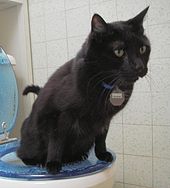
Being fastidious self-cleaners, cats detest their own waste and instinctually bury their urine and feces. House cats are usually provided with a box containing litter, generally consisting of bentonite, but sometimes other absorbent material such as shredded paper or wood chips, or sometimes sand or similar material can be used. It should be cleaned daily and changed often, depending on the number of cats using it and the type of litter; if it is not kept clean, a cat may be fastidious enough to find other locations for urination or defecation. This may also happen for other reasons; for instance, if a cat becomes constipated and defecation is uncomfortable, it may associate the discomfort with the litter box and avoid it in favor of another location.
Daily attention to the litter box also serves as a monitor of the cat's health. Bentonite or clumping litter is a variation which absorbs urine into clumps which can be sifted out along with feces, and thus stays cleaner longer with regular sifting, but has sometimes been reported to cause health problems in some cats.[65]
Some cats can be trained to use the human toilet, eliminating the litter box and its attendant expense, unpleasant odor, and the need to use landfill space for disposal.
An exhibit at the San Diego Natural History Museum states that cat feces from urban runoff carry Toxoplasma gondii parasites to the ocean and kill sea otters.[66]
Pet humanization
[edit]Pet humanization is a form of anthropomorphism in which cats are kept for companionship and treated more like human family members than traditional pets.[67] This trend of pet culture involves providing cats with a higher level of care, attention and often even luxury, similar to the way humans are treated.[68] The phenomenon of pet humanization refers to cats that are treated, cared for and valued in a manner that mirrors the way humans are treated within a family or social context. It involves attributing human-like qualities, emotions and needs to cats and providing them with care, attention and comforts similar to those given to human family members. In a pet-humanized context, cats kept as pets are often regarded as beloved members of the family, rather than just animals or possessions.
Genetic similarities with humans
[edit]Cats and humans evolutionarily diverged from a common ancestor (boreoeutherian ancestor) approximately 80 million years ago, accumulating only 10–12 chromosomal translocations.[69] The order of eight genes on the cats' Y chromosome closely resembles that in humans.[70] Genes on X chromosomes of cats and humans are arranged in a similar way.[70]
Domestic cats are affected by over 250 naturally occurring hereditary disorders, many of which are similar to those in humans, such as diabetes, hemophilia and Tay–Sachs disease.[70][71] For example, Abyssinian cat's pedigree contains a genetic mutation that causes retinitis pigmentosa, which also affects humans.[71] The domestic cat is also an excellent model for human infectious diseases, including HIV/AIDS.[71] Feline immunodeficiency virus (FIV) is a genetic relative of HIV.[71]
See also
[edit]References
[edit]- ^ "About Pets". IFAH Europe. Archived from the original on 6 October 2014. Retrieved 3 October 2014.
- ^ Legay, J. M. (1986). "Tentative estimation of the total number of domestic cats in the world". Comptes Rendus de l'Académie des Sciences, Série III. 303 (17): 709–712. PMID 3101986.
- ^ "Cats: Most interesting facts about common domestic pets". Pravda. Archived from the original on 6 October 2014. Retrieved 3 October 2014.
- ^ "Study Traces Cat's Ancestry to Middle East". The New York Times. Retrieved 3 October 2014.
- ^ Gehrt, Stanley D.; Riley, Seth P. D.; Cypher, Brian L. (12 March 2010). Urban Carnivores: Ecology, Conflict, and Conservation. JHU Press. ISBN 9780801893896. Retrieved 3 October 2014.
- ^ Rochlitz, Irene (17 April 2007). The Welfare of Cats. Springer Science & Business Media. ISBN 9781402032271. Retrieved 3 October 2014.
- ^ Turner, Dennis C.; Bateson, Patrick, eds. (2000). The Domestic Cat: The Biology of its Behaviour (2nd ed.). Cambridge University Press. ISBN 0521636485.
- ^ "Market Research Statistics – U.S. Pet Ownership". American Veterinary Medical Association. Archived from the original on 4 May 2012. Retrieved 27 August 2009.
- ^ Thomas, Robert McG. Jr. (6 October 1995). "Edward Lowe Dies at 75; a Hunch Led Him to Create Kitty Litter". The New York Times. Retrieved 8 March 2013.
- ^ a b Jones, Jeffrey M. (30 November 2007). "Companionship and Love of Animals Drive Pet Ownership". Gallup, Inc. Retrieved 30 August 2009.
- ^ Richards, James R. (1 September 1999). ASPCA Complete Guide to Cats. San Francisco: Chronicle Books. p. 65. ISBN 0811819299.
- ^ a b Kale, Sirin (22 July 2021). "The hidden world of cats: What our feline friends are doing when we're not looking". The Guardian. Retrieved 23 July 2021.
- ^ Moran, D. J.; Patterson, Jennifer L. (16 June 2011). "When More Isn't Enough". Psychology Today.
- ^ "What Is That They're Wearing?" (PDF). Humane Society of the United States. Archived from the original (PDF) on 1 December 2006. Retrieved 22 October 2009.
- ^ "EU proposes cat and dog fur ban". BBC News. 20 November 2006. Retrieved 22 October 2009.
- ^ Ikuma, Carly (27 June 2007). "EU Announces Strict Ban on Dog and Cat Fur Imports and Exports". HSUS.org. Humane Society International. Archived from the original on 17 February 2009. Retrieved 14 December 2011.
- ^ Paterson, Tony (25 April 2008). "Switzerland Finds a Way to Skin a Cat for the Fur Trade and High Fashion". The Independent. London, England. Retrieved 23 October 2009.
- ^ Slesnick, Irwin L. (2004). Clones, Cats, and Chemicals: Thinking Scientifically About Controversial Issues. National Science Teachers Association. p. 9. ISBN 9780873552370.
- ^ Hill, Dennis S. (2008). Pests of Crops in Warmer Climates and Their Control. Springer. p. 120. ISBN 9781402067372.
- ^ "Origin and meaning of mouser". Online Etymology Dictionary. Retrieved 16 January 2018.
- ^ "History of 10 Downing Street". Gov.uk. Retrieved 16 January 2018.
- ^ Lipinski, Monika J.; Froenicke, Lutz; Baysac, Kathleen C.; Billings, Nicholas C.; Leutenegger, Christian M.; Levy, Alon M.; Longeri, Maria; Niini, Tirri; Ozpinar, Haydar (January 2008). "The ascent of cat breeds: Genetic evaluations of breeds and worldwide random-bred populations". Genomics. 91 (1): 12–21. doi:10.1016/j.ygeno.2007.10.009. PMC 2267438. PMID 18060738.
- ^ a b c Kravetz, J. D.; Federman, D. G. (2002). "Cat-associated zoonoses". Archives of Internal Medicine. 162 (17): 1945–1952. doi:10.1001/archinte.162.17.1945. PMID 12230416.
- ^ Talan, D. A.; Citron, D. M.; Abrahamian, F. M.; Moran, G. J.; Goldstein, E. J. (1999). "Bacteriologic analysis of infected dog and cat bites. Emergency Medicine Animal Bite Infection Study Group". New England Journal of Medicine. 340 (2): 85–92. doi:10.1056/NEJM199901143400202. PMID 9887159.
- ^ Torda, A. (2001). "Toxoplasmosis. Are cats really the source?". Australian Family Physician. 30 (8): 743–747. PMID 11681144.
- ^ Svobodová, V.; Knotek, Z.; Svoboda, M. (1998). "Prevalence of IgG and IgM antibodies specific to Toxoplasma gondii in cats". Veterinary Parasitology. 80 (2): 173–176. doi:10.1016/S0304-4017(98)00201-5. PMID 9870370.
- ^ Meireles, L. R.; Galisteo, A. J.; Pompeu, E.; Andrade, H. F. (2004). "Toxoplasma gondii spreading in an urban area evaluated by seroprevalence in free-living cats and dogs". Tropical Medicine & International Health. 9 (8): 876–881. doi:10.1111/j.1365-3156.2004.01280.x. PMID 15303992. S2CID 35384028.
- ^ De Craeye, S.; Francart, A.; Chabauty, J. (2008). "Prevalence of Toxoplasma gondii infection in Belgian house cats". Veterinary Parasitology. 157 (1–2): 128–132. doi:10.1016/j.vetpar.2008.07.001. PMID 18707811.
- ^ McAuliffe, Kathleen (6 February 2012). "How Your Cat Is Making You Crazy". The Atlantic. Retrieved 3 June 2013.
- ^ "Allergic to Your Pet? Learn about Dog and Cat Allergies". www.aafa.org. Retrieved 4 February 2022.
- ^ Erwin, E. A.; Woodfolk, J. A.; Custis, N.; Platts-Mills, T. A. (2003). "Animal danders". Immunology and Allergy Clinics of North America. 23 (3): 469–481. doi:10.1016/S0889-8561(03)00004-3. PMID 14524386.
- ^ Miller, Henry (2005). "Cat and Mouse in Regulating Genetic 'Enhancement'". Nature Biotechnology. 23 (2): 171–172. doi:10.1038/nbt0205-171. PMID 15696141. S2CID 20754103.
- ^ Satorina, Julia; Szalai, Krisztina; Willensdorfer, Anna; Mothes-Luksch, Nadine; Lukschal, Anna; Jensen-Jarolim, Erika (17 March 2014). "Do hypoallergenic cats exist? -- Determination of major cat allergen Fel d 1 production in normal and hypoallergenic cat breeds". Clinical and Translational Allergy. 4 (2): 11. doi:10.1186/2045-7022-4-S2-P11. ISSN 2045-7022. PMC 4072467.
- ^ "Dealing with cat allergies" (PDF). animaltrustees.org. Archived from the original (PDF) on 4 June 2007.
- ^ Simpson, A.; Custovic, A. (2003). "Early pet exposure: Friend or foe?". Current Opinion in Allergy and Clinical Immunology. 3 (1): 7–14. doi:10.1097/00130832-200302000-00002. PMID 12582308. S2CID 5713721.
- ^ Simpson, A.; Custovic, A. (2005). "Pets and the development of allergic sensitization". Current Allergy and Asthma Reports. 5 (3): 212–220. doi:10.1007/s11882-005-0040-x. PMID 15842959. S2CID 22582593.
- ^ Avner, D. B.; Perzanowski, M. S.; Platts-Mills, T. A.; Woodfolk, J. A. (1997). "Evaluation of different techniques for washing cats: quantitation of allergen removed from the cat and the effect on airborne Fel d 1". Journal of Allergy and Clinical Immunology. 100 (3): 307–312. doi:10.1016/S0091-6749(97)70242-2. PMID 9314341.
- ^ Allen, K.; Blascovich, J.; Mendes, W. B. (2002). "Cardiovascular reactivity and the presence of pets, friends, and spouses: the truth about cats and dogs". Psychosomatic Medicine. 64 (5): 727–739. doi:10.1097/01.PSY.0000024236.11538.41. PMID 12271103. S2CID 32265127.
- ^ Fogle, Bruce, ed. (1981). Interrelations Between People and Pets. Charles C. Thomas Pub. ISBN 0398041695.
- ^ Turner, Dennis C.; Rieger, G.; Gygax, L. (2003). "Abstract: 'Spouses and Cats and Their Effects on Human Mood'". ScientificCommons.org. Berlin: magazine.One UG. Archived from the original on 15 July 2009. Retrieved 25 June 2010.
- ^ Qureshi, A. I.; Memon, M. Z.; Vazquez, G.; Suri, M. F. (2009). "Cat Ownership and the Risk of Fatal Cardiovascular Diseases". Journal of Vascular and Interventional Neurology. 2 (1): 132–135. PMC 3317329. PMID 22518240.
- ^ Serpell, J. (3 October 2011). "Beneficial Effects of Pet Ownership on Some Aspects of Human Health and Behaviour". Journal of the Royal Society of Medicine. 84 (12): 717–720. doi:10.1177/014107689108401208. PMC 1295517. PMID 1774745.
- ^ London, Louis S. (January 1952). "Ailurophobia and ornithophobia: Cat phobia and bird phobia". The Psychiatric Quarterly. 26 (1–4): 365–371. doi:10.1007/BF01568473. PMID 14949213. S2CID 30238029.
- ^ Barnhill, John W. (April 2020). "Specific Phobic Disorders". Merck Manuals - Professional Version. Archived from the original on 28 April 2015. Retrieved 3 June 2021.
- ^ Milosevic, Irena; McCabe, Randi E. (2015). Phobias: The Psychology of Irrational Fear. Santa Barbara, California: ABC-CLIO. pp. 11–12. ISBN 9781610695756. OCLC 895030322.
- ^ "Brighton cat killer jailed". Crown Prosecution Service. 30 July 2021. Archived from the original on 14 February 2023.
- ^ "10 Best Emotional Support Cats Breeds". ESA Registration of America. Retrieved 11 February 2022.
- ^ "Therapy Cats & Rabbits – Love On A Leash®". Love on a Leash. Retrieved 11 February 2022.
- ^ Bernstein, Penny L. (2007). "The Human-Cat Relationship". The Welfare of Cats. "Animal Welfare" series. Vol. 3. Springer Netherlands. pp. 47–89. doi:10.1007/978-1-4020-3227-1_3. ISBN 9781402032264. Retrieved 11 February 2022.
- ^ Wilson Fuoco, Linda (24 July 2010). "Pet Tales: Paralyzed therapy cat inspires patients". Pittsburgh Post-Gazette. Retrieved 14 January 2012.
- ^ a b "Pet therapy for humans who need it most". Naperville Sun. Associated Press. 4 August 2011. Archived from the original on 3 February 2013. Retrieved 14 January 2012.
- ^ a b c "Even hairless Sphynx cats give patients a warm, fuzzy feeling". USA Today. Associated Press. 1 December 2009. Retrieved 14 January 2012.
- ^ a b "Missing NY therapy cat found". The Wall Street Journal. Associated Press. 10 January 2012. Archived from the original on 9 February 2013. Retrieved 14 January 2012.
- ^ a b "Jersey City dance school mourns loss of therapy cat". The Jersey Journal. 4 March 2011. Retrieved 14 January 2012.
- ^ Grad, Shelby (4 June 1993). "Show Cats Just Purrfect for Therapy". Los Angeles Times. Retrieved 14 January 2012.
- ^ Center, AniMeals No-Kill Adoption; Bank, Animal Food (10 April 2012). "The Special Love of Therapy Cats". Animeals.WordPress.com. Retrieved 11 February 2022.
- ^ Tomaszewska, Katarzyna; Bomert, Iga; Wilkiewicz-Wawro, Elżbieta (1 August 2017). "Feline-assisted therapy: Integrating contact with cats into treatment plans". Polish Annals of Medicine. 24 (2): 283–286. doi:10.1016/j.poamed.2016.11.011. Retrieved 11 February 2022.
- ^ Landsberg, G. M. (1991). "Feline scratching and destruction and the effects of declawing". Veterinary Clinics of North America: Small Animal Practice. 21 (2): 265–279. doi:10.1016/s0195-5616(91)50032-2. PMID 2053250.
- ^ "FAB Information Sheet: Scratching or Clawing in the House". FABCats.org. Tisbury, England: Feline Advisory Bureau. February 2008. Retrieved 14 August 2005.
- ^ a b Swiderski, J. (2002). "Onychectomy and its alternatives in the feline patient". Clinical Techniques in Small Animal Practice. 17 (4): 158–161. doi:10.1053/svms.2002.36604. PMID 12587280.
- ^ a b Welfare Implications of Declawing of Domestic Cats Archived 13 March 2014 at archive.today American Veterinary Medical Association 9 April 2009
- ^ Patronek, G. J. (2001). "Assessment of claims of short- and long-term complications associated with onychectomy in cats". Journal of the American Veterinary Medical Association. 219 (7): 932–937. doi:10.2460/javma.2001.219.932. PMID 11601788. Archived from the original on 7 August 2010.
- ^ "Paw Project Acknowledgements". Pawproject.org. 20 February 2011. Archived from the original on 16 August 2011. Retrieved 30 October 2011.
- ^ "Issues: AVMA Policy: Declawing of Domestic Cats". AVMA.org. American Veterinary Medical Association. April 2009. Archived from the original on 29 June 2010. Retrieved 30 July 2010.
- ^ Hornfeldt, CS; Westfall (1996). "Suspected bentonite toxicosis in a cat from ingestion of clay cat litter". Veterinary and Human Toxicology. 38 (5): 365–366. PMID 8888544.
- ^ "Parasite Shed in Cat Feces Kills Sea Otters" (PDF).
- ^ The Rise of Pet Humanization
- ^ The Humanization of Pets
- ^ Ruvinsky, Anatoly; Marshall Graves, Jennifer A. (2005). Mammalian Genomics. CABI. p. 365. ISBN 0851990754.
- ^ a b c Guynup, Sharon (21 April 2000). "Cats and humans share similar X and Y chromosomes". Genome News Network. Retrieved 14 February 2015.
- ^ a b c d "Domestic cat genome sequenced". Genome Research. Cold Spring Habor Laboratory Press. Retrieved 14 February 2015.

